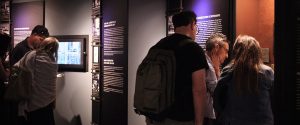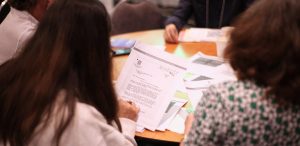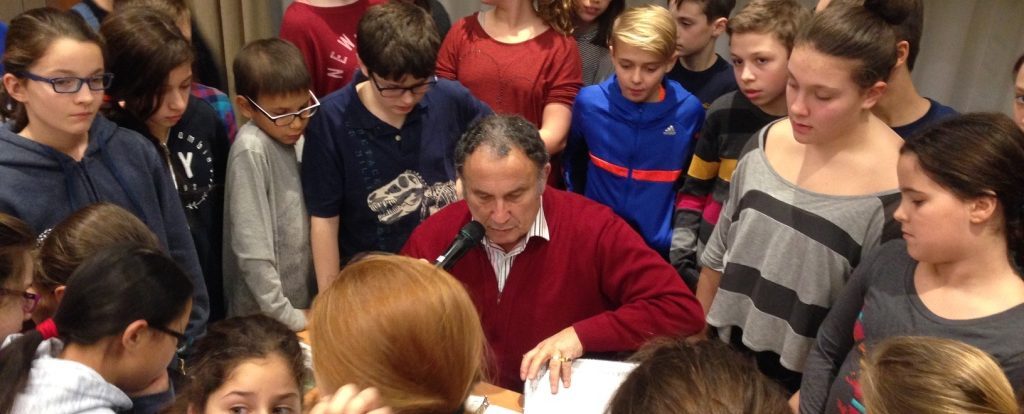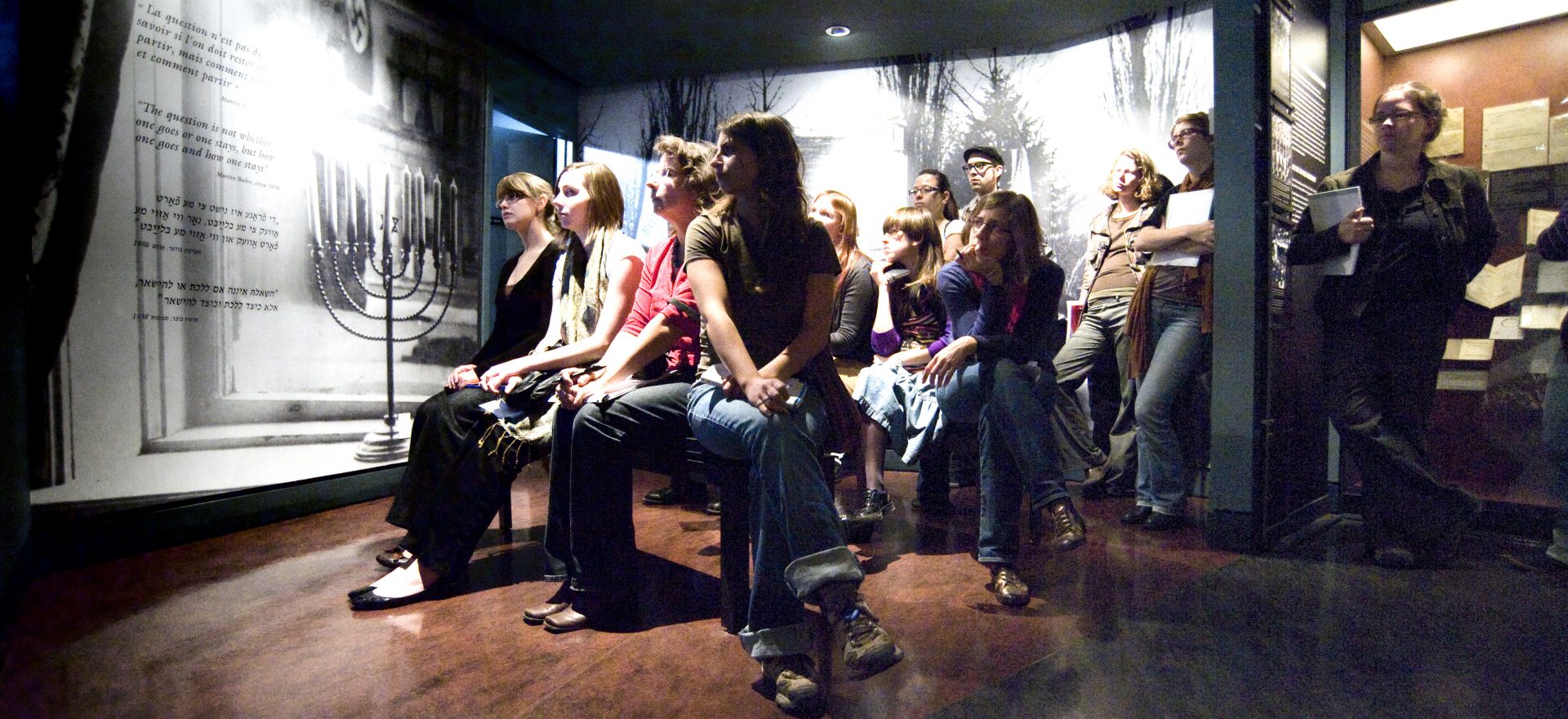Tours of the permanent exhibition

Guided Tour | gr. 6 and up | 90 min.
10 to 48 participants, or more if a second program is booked for the same group
The guided tour offers participants the opportunity to discover the history of the Holocaust through in-depth explanations from our guides. The knowledge and the anecdotes they share allow participants to learn more about the objects and testimonies presented in our permanent exhibition and to humanize the victims of the Holocaust.

Discovery Tour | gr. 6-Sec. 5 | 90 min.
10 to 35 participants, or more if a second program is booked for the same group
During this immersive tour experience, students explore the objects in the exhibit and reflect on how they contribute to illustrating the history of the Holocaust.
In each section of the museum, a guide provides historical context before students embark on the exploration phase. Students work in small groups to observe and analyze the objects on display in order to understand how they illustrate the lived experience of Jewish communities. At the end of each section, a group discussion enables the tour guide to assess understanding and answer questions.

Self-Guided Tour | Sec. 1 and up | 60 min.
10 to 60 participants, or more if a second program is booked for the same group
The self-guided tour allows participants to discover the Museum’s permanent exhibition on their own (without a guide). After a brief introduction by one of our front desk agents, participants can explore, at their own pace, the history of Jewish communities before, during and after the Holocaust. For groups who are interested, an activity sheet provides historical context and focuses the visit on certain objects in the exhibition.

Learn more about our permanent exhibition.
Themes covered in the permanent exhibit:
- 1st Section (early 20th century): Jewish communities in Europe and North Africa, Jewish traditions and holidays.
- 2nd Section (1919-1939): Treaty of Versailles and the Weimar Republic, Hitler’s accession to power, persecution of the Jews, propaganda, the reaction of German Jews, the pogrom of the Night of Broken Glass, the reaction of Canada and the world.
- 3rd Section (1939-1950): The invasion of Poland, non-Jewish victims, the ghettos, deportation, concentration camps, armed and spiritual resistance, the Righteous Among the Nations, the collaborators
- 4th Section (1945-1955): Liberation, displaced persons’ camps, immigration of survivors to Canada.
Educational Workshops

Edith Maniker’s interactive biography | gr. 6 – Sec. 2 | 60 min.
10 to 60 participants or more if a second program is booked for the same group
KEY THEMES : TESTIMONY, GERMANY, KINDERTRANSPORT
Dimensions in Testimony, a technology developed by the USC Shoah Foundation, enables participants to interact with Edith Maniker’s pre-recorded testimony, and discover her personal experience as a Holocaust survivor.
Accompanied by a mediator, participants are invited to converse with Edith Maniker, asking her numerous questions about her experience before, during and after the Holocaust. The answers to their questions are selected from pre-recorded responses given by Edith.

Max Eisen’s interactive biography | Sec. 3 and up | 60 min.
10 to 60 participants or more if a second program is booked for the same group
KEY THEMES : TESTIMONY, CZECHOSLOVAKIA, AUSCHWITZ
Dimensions in Testimony, a technology developed by the USC Shoah Foundation, enables participants to interact with Max Eisen’s pre-recorded testimony, and discover his personal experience as a Holocaust survivor.
Accompanied by a mediator, participants are invited to converse with Max Eisen, asking him numerous questions about his experience before, during and after the Holocaust. The answers to their questions are selected from pre-recorded responses given by Max.

Life in Hiding workshop: Eva Kuper’s story | gr. 6 – Sec. 1 | 60 min.
10 to 48 participants at the Museum, or more if a second program is booked for the same group
KEY TOPICS: HIDDEN CHILD –CHERISHED BELONGINGS
In this workshop, participants will discover Eva Kuper’s story. Eva was born in Warsaw in 1940, shortly after the Nazi invasion of Poland. A few months after her birth, her family was confined to the Jewish ghetto in Warsaw. After her mother was deported, Eva and her father managed to escape from the ghetto. They survived the war in hiding.
Through watching a video excerpt of Eva’s testimony and analyzing reproductions of artefacts that belonged to children and teenagers who survived the Holocaust in hiding, students will discover what life was like for them under the Nazi occupation and reflect on the difficult choices they had to make.

Finding Refuge in Canada workshop: the Cahn family’s story | Sec. 2-4 | 60 min.
10 to 48 participants at the Museum, or more if a second program is booked for the same group
KEY TOPICS : ANTISEMITISM – DENIAL OF FREEDOMS – CANADA’S ROLE
In this workshop, participants will discover how the anti-Jewish measures imposed by Nazi Germany had a direct impact on the Cahn family’s life. They will then understand how the family was able to find refuge in Canada through the help of a family friend, Mr. William Birks.
Participants will begin by analyzing primary sources which belonged to the Cahn family. They will then place these primary sources into context to better understand the Holocaust and how Canada responded to Nazi persecution.

Resistance during the Holocaust workshop: the Feigenbaum family story | Sec. 3 and up | 60 min.
10 to 48 participants at the Museum, or more if a second program is booked for the same group
KEY TOPICS : STAGES OF GENOCIDE – RESISTANCE
In this workshop, participants will discover the story of Avrum Feigenbaum and his family during the Holocaust. The Feigenbaum family lived in Lodz, Poland, before the war. After the invasion of Poland by Nazi Germany, the family was imprisoned in the ghetto where Avrum’s father died from starvation. The rest of the family was successively deported to Auschwitz. Out of seven family members, only Avrum and his brother, Hersh, survived.
Through analyzing primary sources (documents and testimonies), participants will better understand the different stages of genocide, as well as how Avrum and his family resisted at every stage.
This workshop was designed to complement the teacher’s guide Studying Genocide.

Testimony with a Holocaust Survivor

Survivor testimony | Sec. 1 and up | 60 min.
10 to 60 participants at the museum or more if a second program is booked for the same group
A survivor testimony adds a personal dimension to the history of the Holocaust and the millions of victims. It puts students in direct personal contact with a complex and incomprehensible part of history.

Prepare your group by consulting our resources:
Thank you to Desjardins for supporting school visits





